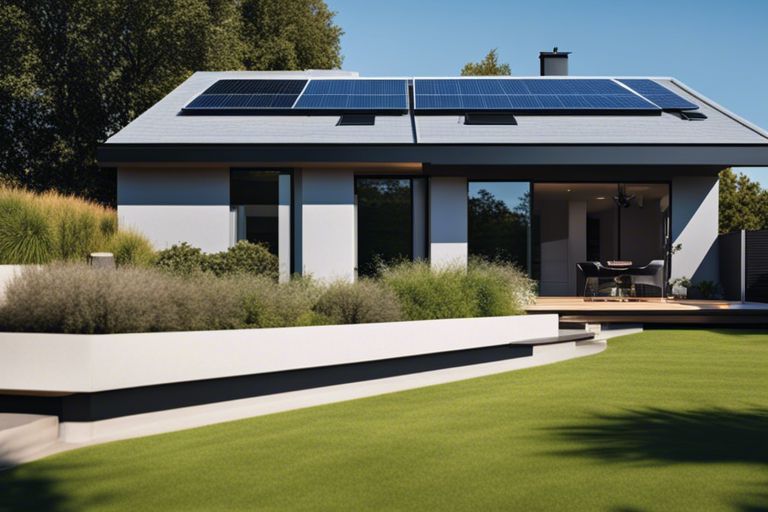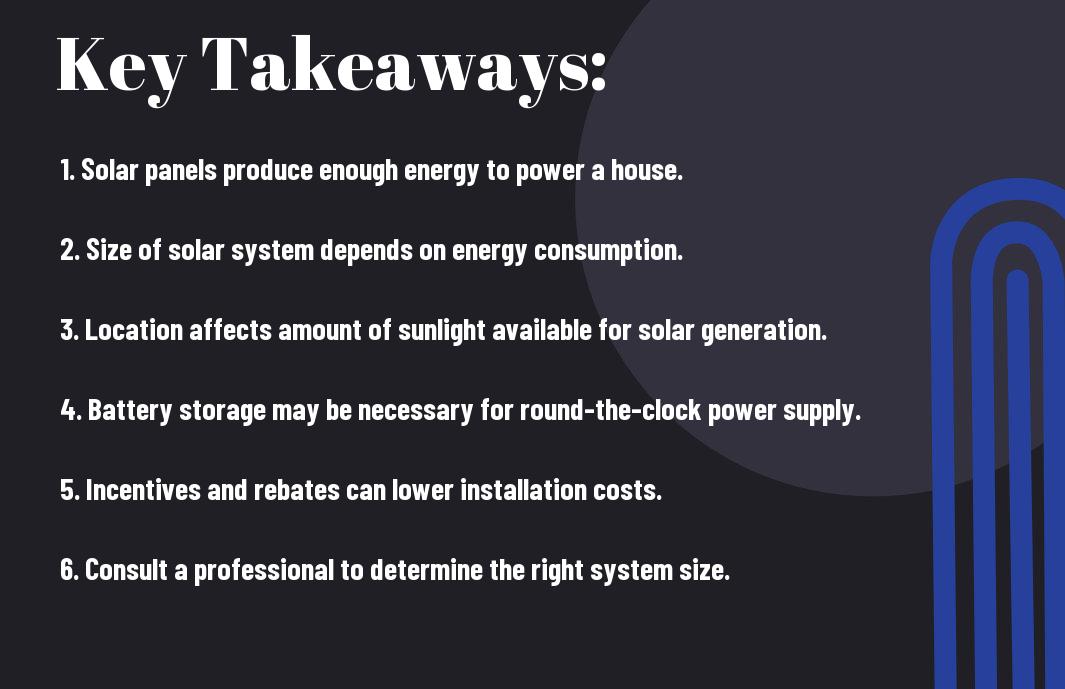You might be wondering just how much solar power you need to fully power your house and break free from the grip of traditional energy sources. In this blog post, we will probe into the factors that determine the amount of solar power required to meet your energy needs. By understanding your electricity consumption patterns, the efficiency of solar panels, and other key considerations, you’ll be equipped to make informed decisions about transitioning to clean, renewable energy for your home.
Key Takeaways:
- Energy Consumption: The amount of solar power needed to fully power a house depends on the energy consumption of the household.
- Rooftop Space: The roof space available for solar panels will determine how many panels can be installed to generate sufficient power.
- Location: The location of the house affects the efficiency of solar panels, with sunnier regions generally requiring less solar panels.
- Battery Storage: Adding battery storage can help in utilizing solar power during non-sunny hours, ensuring 24/7 power supply.
- Energy Efficiency Measures: Implementing energy-saving practices and appliances can reduce the amount of solar power needed to fully power a house.
The Basics of Solar Power
What is Solar Energy?
Solar energy is a renewable source of power that comes from the sun. It is a clean and sustainable alternative to traditional fossil fuel energy sources. When sunlight hits solar panels, it generates electricity through a process called the photovoltaic effect.
By capturing the sun’s energy and converting it into electricity, you can power your home with clean, renewable energy and reduce your carbon footprint.
How Does Solar Power Work?
Basics of how solar power works involve the following steps. Solar panels, made up of photovoltaic cells, capture sunlight and convert it into direct current (DC) electricity. An inverter then converts this into alternating current (AC) electricity that can be used to power your home. Excess electricity can be stored in batteries for later use, or it can be fed back into the grid, earning you credits through net metering.
With advancements in technology and increased affordability, solar power systems have become more accessible to homeowners. Installing solar panels on your rooftop allows you to harness the sun’s energy efficiently and effectively power your home.
Assessing Your Energy Needs
Assuming you are considering solar power for your home, you’ll first need to assess your energy needs. To determine how much solar power you require, you should calculate your energy consumption. You can find detailed information on how to calculate this on How many watts does a home solar system need to power one household in the United States? This will give you a good starting point to understand the energy demands of your household.
Calculating Your Energy Consumption
To accurately estimate your energy consumption, you need to consider various factors such as the number of appliances you use, their energy efficiency ratings, how long they are used daily, and seasonal variations in your energy usage. By examining your past utility bills, you can get a clear picture of your average monthly kilowatt-hour consumption. This data will assist you in determining the size of the solar power system you need to meet your energy requirements.
Factors Affecting Energy Usage
- The size of your household and the number of occupants will significantly impact your energy needs. Larger families will generally consume more energy than smaller ones.
- Your location and the climate in which you live play a crucial role in the amount of sunlight your solar panels can capture. Regions with more sunlight will generate more solar energy.
Recognizing these factors will help you make informed decisions about the size and type of solar power system that best suits your household’s energy needs.
Determining the Required Solar Panel Capacity
Measuring Your Roof’s Solar Potential
Keep in mind that not all roofs are created equal when it comes to solar potential. Factors such as the size, angle, orientation, and shading of your roof can significantly impact how much sunlight your solar panels will receive. To determine your roof’s solar potential, you can use online tools or consult with a solar energy professional who can assess your roof’s suitability for solar panel installation.
Sizing Your Solar Panel System
Determining the required solar panel capacity for your household involves considering your energy consumption habits, location, and the amount of sunlight your roof receives. Any excess electricity generated by your solar panels can be stored in batteries or fed back into the grid for credits. It’s vital to accurately size your solar panel system to ensure it meets your energy needs while staying within your budget.
A properly sized solar panel system typically takes into account your average daily energy usage, peak sunlight hours in your area, and any future changes in energy consumption. By assessing these factors, you can determine the optimal solar panel capacity to fully power your home.

The Role of Efficiency and Losses
Understanding Solar Panel Efficiency
Now, let’s research into the importance of understanding solar panel efficiency. Solar panel efficiency refers to how well a solar panel can convert sunlight into usable electricity. The efficiency of solar panels can vary, with some models converting as little as 15% of sunlight into electricity, while others can achieve efficiencies of over 20%. When considering how much solar power you need to fully power your home, it’s important to take into account the efficiency of the solar panels you are using.
Accounting for Energy Losses
Accounting for energy losses is crucial when calculating the amount of solar power required to fully power your home. Energy losses can occur during the conversion of sunlight into electricity, as well as during the storage and distribution of that electricity. Factors such as wiring resistance, inverter efficiency, and battery storage losses can all contribute to energy losses. It’s important to factor in these losses when determining the size of your solar power system to ensure you generate enough electricity to meet your household’s needs.
Plus, it’s important to consider environmental factors such as shading from nearby trees or buildings, as well as the angle and orientation of your solar panels, which can impact the overall efficiency of your system. By understanding and accounting for these efficiency and loss factors, you can better estimate the amount of solar power needed to fully power your home.
Real-World Examples and Scenarios
A Typical Single-Family Home
For a typical single-family home, the amount of solar power needed to fully power your house will depend on factors such as your location, energy consumption habits, and the size of your home. On average, a household in the United States uses about 10,972 kilowatt-hours (kWh) of electricity per year. To fully power your home with solar energy, you would need a solar panel system that can generate around 9,143 kWh per year, taking into account efficiency losses and other variables.
Larger Homes and Commercial Properties
Real-world scenarios for larger homes and commercial properties can vary greatly. If you have a larger home or own a commercial property, the solar power needed to fully cover your energy consumption will be higher compared to a typical single-family home. You may require a larger solar panel system, energy storage solutions, or a combination of solar and traditional power sources to meet your energy needs.
It’s important to consult with a professional solar installer to assess your energy consumption patterns, property size, and other relevant factors to determine the right solar power setup for your larger home or commercial property.

Overcoming Common Challenges
Dealing with Shading and Obstructions
Once again, shading and obstructions can pose challenges to fully powering your house with solar energy. An obstruction like a tall building or tree can cast shadows on your solar panels, reducing their efficiency. To overcome this, consider trimming trees or adjusting the placement of your panels to maximize sunlight exposure throughout the day. Additionally, installing microinverters on each panel can help mitigate the impact of shading on your overall system.
Addressing Energy Storage and Backup Needs
Backup power and energy storage are crucial aspects to consider when fully powering your house with solar. Backup power systems like batteries can store excess energy generated during the day for use at night or during cloudy days. These systems ensure a reliable power supply even when the sun isn’t shining. Addressing your energy storage and backup needs can give you peace of mind knowing that your home will remain powered regardless of external factors.
Backup generators can also be a viable option to provide supplemental power during extended periods of low sunlight or in case of emergencies. While solar panels are a sustainable and cost-effective solution for powering your home, having a backup plan for energy storage and backup power ensures uninterrupted electricity supply.

Final Words
Upon reflecting on the amount of solar energy needed to fully power a house, it’s clear that the answer can vary based on a multitude of factors such as location, energy consumption habits, and the efficiency of the solar panels. While it’s possible to completely power a home with solar energy, it requires careful planning, investment in high-quality equipment, and a commitment to energy conservation.
Note, switching to solar power is not only beneficial for the environment but can also lead to long-term savings on your energy bills. By understanding your energy needs and choosing the right solar setup for your home, you can take a significant step towards a more sustainable and cost-effective energy future. So, if you’re considering making the switch to solar, do your research, consult with experts, and make an informed decision that aligns with your goals and values.
FAQ
Q: How much solar power does it take to fully power a house?
A: The amount of solar power needed to fully power a house depends on various factors such as the size of the house, the energy consumption of its appliances, and the geographical location. On average, it is estimated that a typical American home requires about 20 to 24 solar panels to cover 100% of its energy needs.
Q: What factors affect the amount of solar power needed to fully power a house?
A: The key factors that affect the amount of solar power needed include the size of the house, the energy consumption habits of its occupants, the efficiency of the solar panels, the amount of sunlight the location receives, and any shading or obstructions that may block sunlight from reaching the panels.
Q: Is it possible for a house to be fully powered by solar energy?
A: Yes, it is entirely possible for a house to be fully powered by solar energy. By installing a sufficient number of solar panels, implementing energy-efficient practices, and potentially incorporating energy storage solutions such as batteries, a house can rely entirely on solar power for its energy needs.
Can you sell power back to the grid in Oregon
